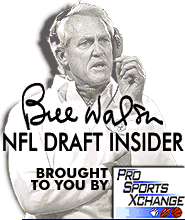
How I Evaluate Each Position:
Halfback
By Bill Walsh
PSX Draft Insider Special
|
|
How I Evaluate Each Position: Halfback By Bill Walsh PSX Draft Insider Special |
HALFBACK
Ideal size: Large enough to take punishment.
There are obvious talents necessary to play the position, but perhaps the most overlooked is durability and stamina. This player must be nearly as effective in the fourth quarter as he was in the first.
You fashion your offense as to the talents of your halfback. Typically, you are looking for the real competitor who is unmoved by the abuse he endures during a game. He is able to focus and concentrate on doing his job every play. He is going to get a lot of abuse and the unexpected is going to happen to him time and time again.
Pure running instincts become critical. You just can't play this position without instincts. There has to be an intuitive style and it differs by degree with every running back there is. Without those instincts, as we learned with Terrance Flagler after we spent a No. 1 pick on him, you can't play the position. In practice, Terrance could do everything that you wanted. But in a game, he just wasn't instinctive. So that is critical.
Now, if he can block effectively, your offense has much more dimension. As a receiver, you'd like to think he is at least an adept screen-pass receiver. And, by degree, the further down the field he can go and catch the ball, the more dimensional your offense becomes.
Even with all these abilities, the most important aspect is probably durability, without which the other talents become of diminished value. You must be able to count on this player if he is a key part of the offensive philosophy.
Size requirements vary. Some smaller runners play big, like James Brooks did at under 190 pounds. The key, along with durability, is that when they are hit they should be able to fall forward.
Despite the instincts you look for, there should be discipline to get the first four yards within the scheme and then rely on instincts to take it beyond that. Of course there are times when an instinctive back does things on his own early in a play. But when you begin to leave the designed play too often, you are not going to serve the team with consistent gains that the offense must count on.